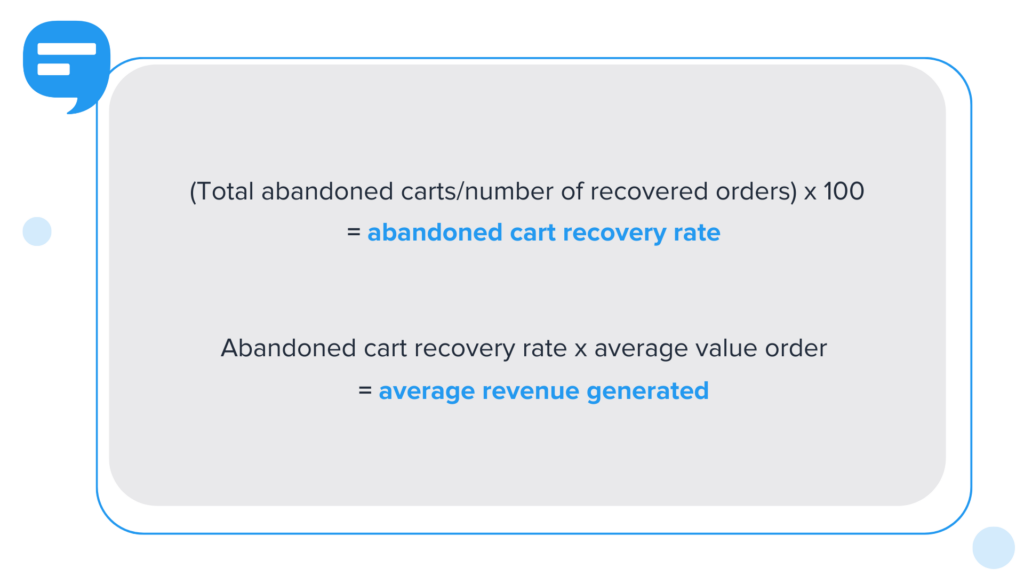Here’s How to Measure Your Abandoned Cart Recovery Rate
Find out what an abandoned cart recovery rate is, how to calculate it for your e-commerce store, and how to improve it.

Find out what an abandoned cart recovery rate is, how to calculate it for your e-commerce store, and how to improve it.

Picture the scene:
You’re throwing a dinner party, and you’ve spent a lot of time getting ready — preparing the food, making the playlist, shoving clutter in the upstairs closet.
But after 30 minutes, you notice that some of the guests have slipped out without eating dinner or even saying goodbye.
Now imagine that scenario with customers in your e-commerce store.
If you run an e-commerce business, it’s disappointing to look at your store’s analytics and realize that a chunk of people came this close to buying — only to leave their online shopping cart untouched without explanation.
We’re firm believers that you can only improve what you can measure. And in the case of improving your abandoned cart recovery rate, you can recapture lost revenue from customers you’ve already spent marketing dollars on.
Once you know what your recovery rate is (I’ll dig into that shortly) and whether it’s higher or lower than the average for your industry, you can figure out the reasons why customers abandon their carts.
Then you’ll know what changes you need to make to give customers that final nudge.
An abandoned cart recovery rate is made up of two things. Let’s break that phrase down and define it.
Here’s a quick example of how you would calculate your abandoned cart recovery rate:
Let’s say 100 shoppers abandoned their carts. If you send an SMS reminder to those people and 20 of them return to complete their purchase, your abandoned cart recovery rate is 20%.
After that, you can figure out the value of the strategy you used to bring customers back with a simple formula. Multiply the number of customers you win back by your average order value (AOV) to get an idea of how much revenue you’ve generated.
(Total abandoned carts/number of recovered orders) x 100 = abandoned cart recovery rate
Abandoned cart recovery rate x average value order = average revenue generated

It’s easy to rationalize that abandoned carts are just a part of e-commerce, but why would you want to miss out on sales if there were an easy way to avoid it?
Calculating your abandoned cart recovery rate gives you a benchmark to measure what is and isn’t working in your marketing strategy.
With the help of some extra feedback and review processes, you can even find out exactly where in the process (and why) your buyer originally dropped off.
When optimize your user experience for the drop-offs, you can start to reclaim the lost potential revenue from abandoned carts.
To find your abandoned cart recovery rate, you’ll first need to know how many abandoned carts your store has generated. Finding this number is pretty simple if you have a Shopify store or if you’re familiar with Google Analytics..
In Shopify, all you need to do is:
Not on Shopify? You can set up and view your checkout processes funnel in Google Analytics. (Yieldify has a helpful guide to setting this up.)
Both sources tell you how many people are leaving your store without making a purchase, which is half the equation. These tools won’t be able to tell you how effective your efforts are to bring customers back.
If you want to see if your abandoned cart recovery efforts are helping, here are two ways to calculate your abandoned cart email or SMS conversion rates.
While you may not know why customers abandoned their cart, adding an incentive to help buyers engage is a good way to move the needle for customers who may be on the fence.
You can then track the number of people who redeem these promo codes and compare them to the number of people who abandoned their carts from your previous view.
If promo codes aren’t your style, we recommend using Google’s free UTM builder to track your recovery rate.
With UTM parameters, you can see the traffic your abandoned cart recovery texts or emails drive to your site and how many people come back to buy because of your messages.
This tool allows you to add parameters to URLs you include in your abandoned cart marketing, which is then visible in Google Analytics.
If the last sentence sounds like gibberish to you, we recommend reading this guide on how to track your SMS campaigns in Google Analytics.
Once you’ve got a good view of your campaigns in Google Analytics, you can more accurately compare the number of purchases in your store to the number of shoppers abandoning their carts.
So, now you know how to find the abandoned cart rate for your store. You may still be wondering, “…is that good?”
That depends on many factors, including your customers’ demographics, the devices they use to shop, your industry, and more.
According to Baymard Institute, the average abandoned cart rate is 70%. But if we drill down further, we see that:
Not crazy about the abandoned cart rate you calculated? Here are some proven ways to improve your numbers.
Unfortunately, you can optimize your checkout process until you’re blue in the face and people will still abandon their carts.
That’s not to say you shouldn’t focus on the user experience and do everything you can to limit friction, but you will reach a ceiling at some point.
That’s where a strong strategy to recover abandoned carts comes into play. By targeting abandoned carts, you can recover close to 33% of those shoppers. That’s a whopping $7,157 in extra revenue.
That kind of impact is why your abandoned cart recovery rate matters.
Drew Wilkinson is the Head of Marketing at SimpleTexting. Drew has more than a decade of experience managing successful integrated marketing programs to build brands, raise awareness, and generate demand.
More Posts from Drew WilkinsonLearn how Matykos Beauty uses SMS to encourage sales, improve their collections, and collect thousands of valuable customer reviews!
ReadHow do you make your Black Friday SMS marketing strategy stand out from the competition? With these six tips and examples.
ReadStart a text marketing campaign or have a 1-on-1 conversation today. It's risk free. Sign up for a free 14-day trial today to see SimpleTexting in action.
No credit card required